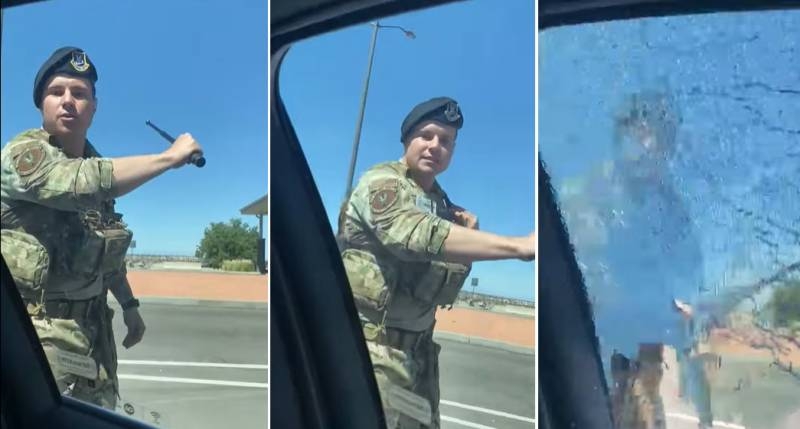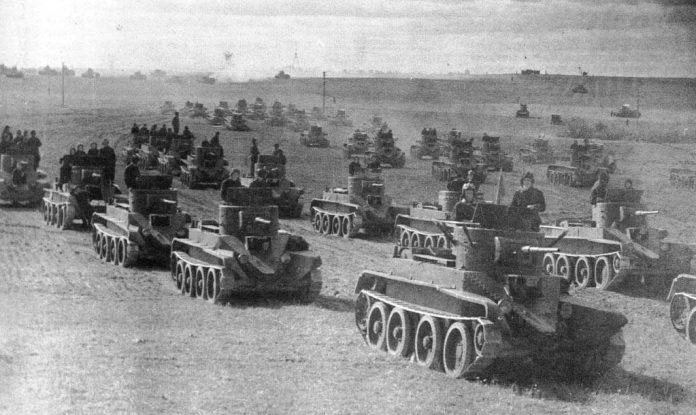
In this article, we will consider some of the features of the organization of domestic tank forces in the pre-war period.. Initially, this material was conceived as a continuation of the cycle “Why T-34 lost PzKpfw III, but I won «tigers» and «Panther»», which would illustrate the changing views of the organization, the role and place of the armored troops of the Red Army in the pre-war and war years, against which the T-34 evolved. But the article was too long, while not going beyond the pre-war years and not even reaching «thirty-fours», and therefore the author decided to offer it to dear readers as a separate material.
Need to say, that the armored forces, to 1929 g. called mechanized troops, and since December 1942 g. - armored and mechanized troops, before the war had a very complex and, moreover, constantly changing structure. But briefly its description could be reduced to the following. In the structure of the armored forces, two directions are clearly visible:
1. Creation of units and subunits for direct interaction with rifle and cavalry divisions;
2. Creation of large mechanized formations, able to independently solve problems in operational cooperation with large combined arms formations, such as the army or the front.
so here, as part of the solution of the first task, a large number of separate tank companies were formed, battalions, mechanized squadrons, armored divisions and regiments, that, usually, were nominally part of rifle and cavalry divisions or brigades.
These formations may not have been in the staff of divisions, but to exist separately, as a means of strengthening them, given for the period of a particular operation. As for the second task, then to solve it, beginning with 1930 city, mechanized brigades were formed, and with 1932 g. - and mechanized corps.
The basis of the mechanized corps was made up of two mechanized brigades, each of which had 4 tank battalion, self-propelled artillery division, rifle-machine gun and sapper battalions, reconnaissance and chemical company. In total, the brigade had 220 tanks, 56 armored vehicles, 27 guns. In addition to the mechanized brigades of the specified composition, mechanized corps included a rifle and machine gun brigade and many support units: reconnaissance battalion, chemical battalion, communications battalion, sapper battalion, anti-aircraft artillery battalion, company regulation and technical base. It is also interesting, that the mechanized brigade, included in the mechanized corps, had their states, different from individual mechanized brigades.
However, the teachings 1932-34 gg. show, that such mechanized corps turned out to be overly bulky and difficult to control, why in 1935 g. their states were reformed.
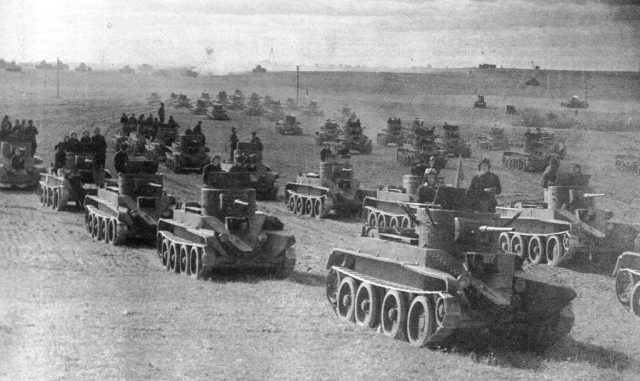 Tanks of the 45th mechanized corps at Kiev maneuvers, 1935 g.
Tanks of the 45th mechanized corps at Kiev maneuvers, 1935 g.
Their basis was still two mechanized brigades, but now of a new composition. The thing is, that by that time the need to unify them in composition with separate mechanized brigades had already been realized, but, surprisingly, it was not possible to do it at that moment. The number of tanks in these formations has decreased, at the same time, T-26 tanks were excluded from the corps mechanized brigades and now they were equipped exclusively with BT. Nevertheless, as can be understood from the descriptions, the corps mechanized brigade still remained unequal to a separate compound of the same type.
As for the rest of the units and divisions, then the mechanized corps retained the rifle and machine gun brigade, but most of the support units were withdrawn from their composition - only the communications battalion and the reconnaissance tank battalion remained. The number of tanks in a mechanized corps by state is now 463 units (there used to be more, but the author is not clear, to what extent). In total, the mechanized corps included 384 BT, and 52 flamethrower tanks and 63 tank T-37.
In general, the mechanized corps remained an unbalanced connection., having, in addition to many tanks, armored vehicles, motorcycles, but practically had no guns in its composition (Total 20 u) and motorized infantry. Cars on such a mechanized corps relied 1 444 PC. Total, beginning with 1932 city, was formed 4 such mechanized corps.
AT 1937 g. the next round of modernizations took place. At first, all mechanized brigades of the Red Army began to gradually be renamed into tank (the process dragged on until 1939 g), and were now divided into light and heavy tank brigades. Their staff and the number of military equipment have changed. The number of tanks increased from 157 to 265 combat and 36 training tanks in brigades, equipped with T-26, or 278 combat and 49 training for teams on BT.
Now the tank brigade was supposed to include 4 battalion of tanks (by 54 tank and 6 ACS in each), as well as one reconnaissance and one motorized rifle battalion, apart from the security parts. Only now it was possible to unify the composition of the corps and individual tank brigades., now the number of tanks in one mechanized corps was 560 combat and 98 training.
And then the strange began.
It would seem, The Red Army is gradually getting on the right track: one side, starting to form large independent tank formations, and on the other, gradually realizing, that they should not be purely tank, but also have their own mobile artillery and motorized infantry. And suddenly, taking a step forward, army leadership takes two steps back:
1. Created in July 1939 d the commission for revising the organizational and staff structure of the troops, although it proposes to keep the tank brigades and mechanized corps, but advocates the exclusion of motorized rifle and rifle-machine gun brigades and battalions from their composition.
2. In October 1939 g. in the Central Committee of the CPSU(b) and the Council of People's Commissars of the USSR sent a plan for the reorganization of the Red Army, according to which the mechanized corps was proposed to disband, and again emphasized the need to withdraw from the staff of tank brigades motorized rifle and rifle-machine gun units.
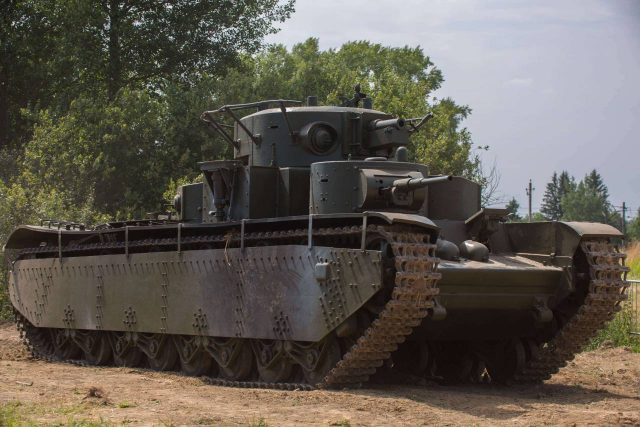
One can assume, that the reason for the abandonment of motorized infantry is connected, Firstly, with a small amount of available vehicles. As we said, according to the state, the same mechanized corps was given almost 1,5 thousand. cars, and this is a lot.
Recall, that the German tank division of the sample 1941 g, having personnel 16 932 pers., that is, surpassing the Soviet mechanized corps mod. 1935 g. by the number of soldiers and officers, one and a half times, had on staff 2 147 cars. But in fact, cars were the eternal Achilles heel in the Red Army., they were never enough, and it can be assumed, that in brigades and mechanized corps their actual number was much lower than the standard.
Most likely there was a situation, when the available vehicle fleet was simply not enough even to service the existing tanks, and there was nothing to transport the motorized infantry, as a result of which the mechanized corps and brigades were actually only partially motorized formations. That is, the same brigade could select a mobile group from its composition, but was not completely mobile. Hence the desire of the members of the commission to "rid" it of the infantry so, to ensure mobility of at least tank battalions in its composition.
As for the disbandment of mechanized corps, then there are no mysteries here, perhaps, which is not. By the time the final decision is made on them, and it happened 21 November 1939 city, 20-1st mechanized corps (more precisely - already a tank corps) managed to fight on Khalkhin Gol, and the 15th and 25th took part in the "Liberation campaign" to Western Belarus and Ukraine. In this way, The Red Army was able to test the real combat capability and mobility of its higher tank formations and, Alas, the results were disappointing.
It turned, that with the existing level of communication and combat training, as well as the real capabilities of the headquarters of the tank corps, managing three teams at the same time is very difficult, and the structure is too bulky. It may seem strange, but in terms of the pace of advance, the 25th Panzer Corps in Belarus and Ukraine managed to lose not only to the cavalry, but even infantry formations. At the same time, individual tank brigades showed significantly better results..
Very often the author of this article had to come across such a point of view in Internet discussions, what in 1939 g. there was a downsizing of the armored forces in the USSR, and that mechanized corps were abandoned in favor of tank brigades. But this, of course, wrong, because until the very end of the 30s of the last century, it was precisely individual mechanized (later - tank) brigades formed the backbone of the Red Army tank forces.
So, eg, at 1938-39 gg. as part of the red army was at least 28 armored brigades (exactly how many mechanized brigades received new numbers when the name was changed), but only 8 of them were included in the mechanized corps. In this way, besides 4 mechanized corps in the Red Army, was, at least, 20 armored brigades, but rather there were still 21. According to others, the number of separate tank brigades reached 28 the end 1937 city, what, however, somewhat doubtful, but by May 1940 g. there were already 39.
In other words, despite the presence of mechanized corps and not taking into account the mass of tanks in rifle and cavalry divisions, the main type of connection of the red army armored forces was a tank brigade, and in this regard, the decision to disband the tank corps did not change anything. Besides, should be considered, that according to the adopted in November 1939 g. decision, instead of four tank corps, to be disbanded, The Red Army was to receive 15 motorized divisions.
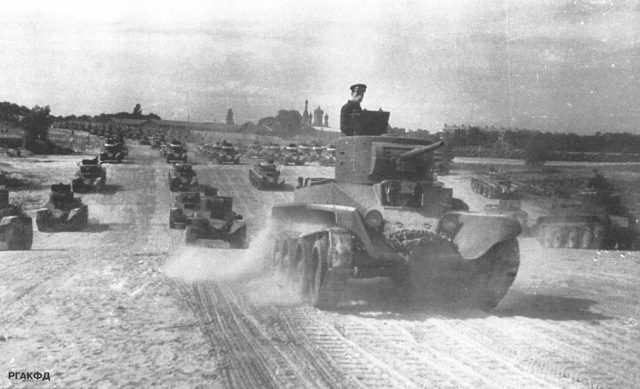
The strength of the new unit was to be 9 000 people. (originally planned for a thousand more, but when they started to form, it was already 9 thousand. pers.) in peacetime. It was not too different from the mechanized corps states, in which, by state 1935 city, in peacetime it should have been 8 965 people. personnel. However, if the mechanized corps had a brigade structure, then the mechanized division consisted of 4 regiments, including tank, artillery and two rifle.
In this way, with approximately equal number of personnel, the number of tanks in a motorized division in comparison with a mechanized corps was reduced from 560 to 257 u, but on the other hand, the number of motorized infantry and artillery increased significantly.
In other words, motorized division 1939 g. turned out to be very close to such a perfect instrument of tank war, what was the German tank division of the sample 1941 g. Yes, of course, the German TD had even more personnel - almost 17 thousand. people. against 12 thousand. people. Soviet MD for the state of war, and there were even fewer tanks in it - from 147 to 229. But, Nevertheless, new soviet connection, apparently, was much closer to the perfect mix of tanks, artillery and motorized infantry, than any similar tank formation of any country in the world in 1939 g.
But how did it happen then, what further, instead of improving such a successful type of tank formation, the Red Army moved along the path of forming giant mechanized corps, which included 3 divisions and more 1000 tanks?
Apparently, the following happened.
first. Need to say, that motorized divisions, depending on point of view, or a little late to be born, to you, conversely, far ahead of their time. The thing is, that their advantage was their versatility, that is, they had enough tanks, artillery and motorized infantry for independent and effective combat operations. but alas, the general level of training of the personnel of the Red Army in 1939 g. simply did not allow the full benefit of, which, in theory, the structure of a motorized division could give.
Finnish war showed "excellent", that the Soviet infantry of that time was poorly trained and did not know how to act in conjunction with tanks, nor jointly with artillery, and the latter did not have a high level of interaction with each other. Such a, completely intolerable situation, was caused by gaping gaps in combat training, and in addition, The Red Army experienced a severe shortage of personnel in terms of competent officers of all levels and junior commanders.
Here, by the way, the blame is by no means the mythical Stalinist repressions, and that, that for a long time the size of the armed forces of the Country of Soviets did not exceed 500 000 pers., and of those, a significant number were territorial troops. Only in the late 1930s, efforts were made to expand the army, but there was no personnel reserve for this.
In other words, to bring four regiments into one division is one, but to achieve that, so that they become a combat-ready tool, capable of 100% unleashing your potential is completely different. At that time, the Red Army did not have any commanders., no headquarters, capable of effectively leading such a division, and a large shortage of commanders of its individual units and subunits, not to mention the rank and file of the Red Army.
second. The formation of motorized divisions was heavily "blurred" by the Soviet-Finnish "winter war" 1939-1940 gg., since they began to create them already in December 1939 city, that is, during hostilities. In this way, motorized divisions could not, they simply did not have time to properly show themselves in battle - they were simply not ready.
third - the Soviet-Finnish war revealed large gaps in the organization of the tank forces of the USSR, which required immediate elimination, but could not be solved by simply building up motorized divisions of the above state.
As mentioned above, in the 30s of the last century it was considered essential to saturate rifle and cavalry divisions with tanks, which were attached to tank formations from a tank company or battalion and up to a regiment. it, yet again, turned out to be theoretically absolutely correct, but at the same time - a premature decision.
Without doubt, the presence of a trained and efficient tank battalion as part of an infantry division significantly increased its capabilities both in defense, so in the offensive. But for this, in addition to the approved staff of the division and the supply of a certain number of tanks with crews to it, it was necessary:
1. From somewhere to take commanders of divisions and officers of divisional headquarters, well acquainted with the capabilities and needs of the tank battalion entrusted to their command, yes and the tanks themselves. That is, it was not enough to give the infantry divisional commander a certain amount of armored vehicles, it was also necessary to teach him to use this armored vehicle.
2. Create conditions for the operation of tanks - that is, least, equip bases, create repair services, arrange timely delivery of spare parts, etc..
3. Create conditions for normal combat training of tanks in the infantry and cavalry divisions.
so here, in fact, none of the above points was fulfilled. The Red Army had a chronic shortage of at least some knowledgeable commanders of rifle divisions. Many of those, who held these positions according to their qualifications, could not effectively command even a purely infantry formation, and then there are tanks ... what kind of tanks, when a significant part of the officers at the radio station looked askance? Of course, This does not mean, that there were absolutely no divisions in the Red Army, able to effectively lead divisions with attached tanks, there were just too few of them.
At the same time, even the tankers, who came to serve in the division (battalion commanders and below), often had educational gaps themselves, and did not know how to properly organize maintenance of complex equipment, had no experience in building interaction with infantry and artillery, did not know how to establish combat training. And if they could, the, often, faced with, that for this corny there was not enough materiel - spare parts for maintenance, etc..
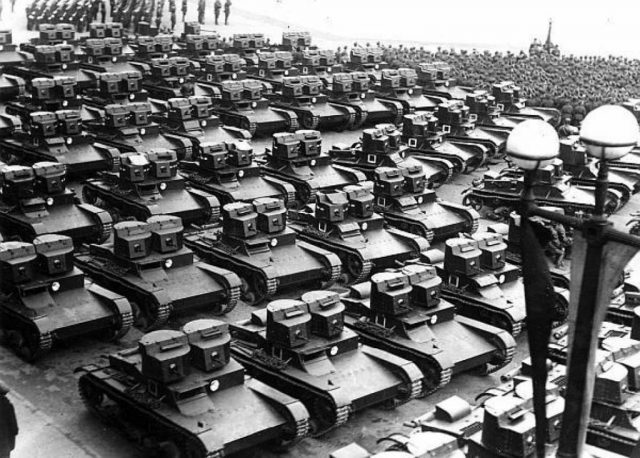
And all this together led to the fact, that the tank units in the infantry formations were, but there was almost no sense in this, division commanders did not know how to use tanks in battle, materiel, transferred to rifle divisions, just not used, so as not to develop a resource, or quickly failed, if someone still tried to do serious preparation. And therefore the conclusion is not at all surprising, made following the results of the "winter war" by the armored subcommittee (20 April 1940 city):
«Based on use in combat conditions, pre-existing and newly created formations: separate tank battalions of the SD, MSD of individual tank companies in the. shelves, tank regiments of the SD, the commission considers these organized units to be completely lifeless. Such organizational forms only lead to a complete dispersal of combat vehicles., misuse (up to the protection of headquarters and rear), impossibility of their timely recovery, and sometimes the impossibility of using them».
It was a very unpleasant fiasco. In fact, stated that, that a significant part of all tanks, delivered to the Red Army, cannot be used for their intended purpose, and if everything is left as it is, then this will lead to their wear and tear without a noticeable increase in the combat effectiveness of rifle and cavalry units. What did the subcommittee suggest??
«All separate tank battalions of rifle and motorized rifle divisions, separate light tank regiments and divisions, except for the 1st and 2nd OKA and personnel cavalry divisions, - to disband and create tank brigades ... ... Categorically prohibit any formations of tank units, except for tank brigades. If there is a need for tanks, send them only in whole brigades.».
Did this mean, that the analysis of hostilities showed that the brigade was optimal for tank forces? No. As we know, nothing like that happened. conversely, It revealed, that tank brigades, being purely tank formations, cannot operate effectively without the support of infantry and artillery (we will not remember about the air force).
So, eg, 17-19 December 1939 g. 20-I am a heavy tank brigade, armed with T-28, unsuccessfully tried to break through the Finnish fortified area Summa-Hotinen. The problem was, what, although the 20th TBR was supposed to be supported by the 50th Rifle Corps, in fact, he could not do this - it all came down to episodic and weak support of the advancing tanks by infantry.
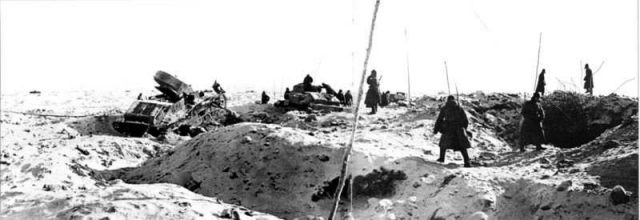 Destroyed tanks of the 20th brigade after the offensive
Destroyed tanks of the 20th brigade after the offensive
In other words, if the rifle divisions did not know how to use tank companies and battalions in their composition, then where did they get the ability to interact with the tank brigade attached to the operation? At the same time, the tankers did not have any artillery., no motorized infantry, to conduct full-fledged hostilities, I had to rely only on tanks, what, naturally, led to their large losses and periodic disruptions of combat missions.
One can assume, that the members of the subcommittee saw and understood all this perfectly, therefore, they did not at all want to abandon the motorized divisions arr. 1939 g. Their recommendations were:
«Maintain the existing organization of motorized divisions. Form 3-4 such divisions in the peacetime state, check them in exercises and combat operations in various directions, then make the appropriate clarification for new formations».
In other words, out so. AT 1940 g. the tank brigade was the most combat-ready unit of the Red Army armored forces. Companies, battalions, shelves, transferred to infantry and cavalry units, demonstrated low efficiency, the larger mechanized corps were too clumsy and poorly controlled, and the motorized divisions have not yet had time to prove themselves. At the same time, the tank brigade, although it was definitely not the ideal tank formation, still was already mastered, army-friendly connection, learned to manage, contain in peacetime, train and apply in battle.
Hence the natural, and an absolutely sensible commission proposal: bring out all (more precisely - almost everything) tanks from rifle divisions and combine them into brigades. AND, simultaneously, in practice, continue to search for a more optimal combination of armored forces, to which the motorized division was presented. And only then, when the structure, the staff and management issues of such a division will be worked out, it will be possible to gradually reorganize the armored forces into new units.
The Red Army has no other reasonable options, generally, and was not, because continuing to keep tanks in separate companies / battalions in rifle divisions meant only aimlessly spending money on their maintenance, but to form a mass of motorized divisions, which could "master" the tanks thus withdrawn, it was impossible. And the same T-26 was not suitable for motorized divisions. Besides, of course, no one interfered with the further use of the newly formed brigades in order to directly support the rifle corps.
Nevertheless, the development of domestic tank forces took a different path - 27 May 1940 g. The People's Commissar of Defense, together with the Chief of General Staff, sent a memorandum to the Politburo and SNK with a proposal to form tank divisions, consisted of two tank regiments, as well as artillery and motorized rifle regiments, and anti-aircraft artillery battalion, and again return to mechanized or tank corps.
Hard to tell, what was the reason for this decision: one side, the idea of creating connections with numbers over 1 000 tanks, according to the memoirs of Marshal M.V.. Zakharova, voiced by no one else, as IV. Stalin. But, according to all the same memories, it was done at the end of May, when the NKO and the chief of the general staff were working hard on the idea of forming tank divisions and corps, so it is unlikely that Joseph Vissarionovich was the initiator of this process.
Most likely, the leadership of the Red Army was impressed by the Polish campaign of the Wehrmacht and the striking power of its tank divisions and corps. At the same time, in one German tank division as of 1939 g. was 324 tanka (unbundling started in 1940 d and further), respectively, two such divisions, united in the corps, gave already in aggregate almost 700 tanks.
So it was in reality, but what information did the leadership of the Red Army have in May 1940 hard to say - unfortunately, domestic intelligence greatly exaggerated the capabilities of the German tank industry. But anyway, german tank corps, even in its actual size, it seemed to be a much more powerful and dangerous compound, than separate armored brigades or motorized divisions. It is not excluded, that this is what led to the desire of our commanders to receive an equivalent "tank fist".
Nevertheless, the memorandum of the NGO from 27 May 1940 g. was rejected: the structure of the tank forces needed to be finalized with the, to meet the staffing level of the Red Army at the level 3 410 thousand. pers., approved by the government. Suggestions have been redone, and the new staffs of the mechanized corps approved 6 July 1940 g. Decree of the Council of People's Commissars of the USSR No. 1193-464ss. The same decree established the states for the tank division., and for the motorized state was adopted, approved by the resolution of NCO No. 215ss adopted 22 May 1940 city
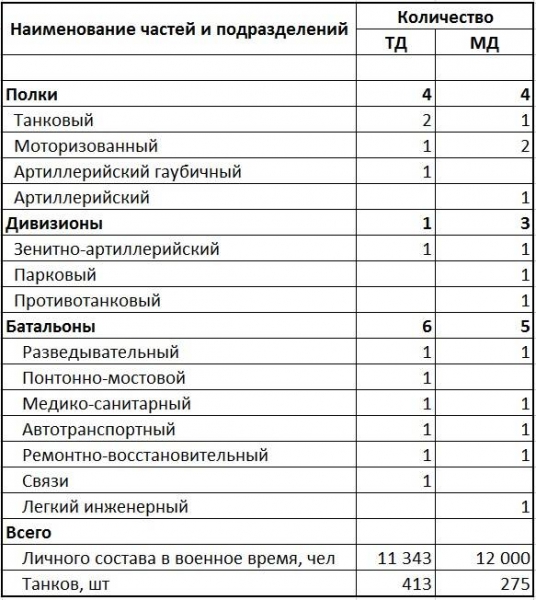
In total, the mechanized corps was supposed to include 2 tank and 1 motorized division and, except them, motorcycle regiment, one air squadron, road and corps communications battalion. Besides, by the same decree, one air brigade was assigned to each MK, consisting of two short-range bomber and one fighter regiments. Last thing, however, not fulfilled.
In this form, MK and existed until the very Great Patriotic War., changes in structure were minimal. So, eg, according to decree No. 1193-464ss, the tank division was supposed to have 386 tanks, but then her staff changed slightly, and in fact their number increased to 413, but later it was reduced to 375 meals.
just 1940 g. it was decided to create 8 mechanized corps. For this purpose, a new structure of the auto-armored forces was introduced., which involved the creation 18 armored, 8 motorized divisions, and 25 armored brigades, not counting the units attached to other units. Wherein 16 tank and 8 motorized divisions were intended to form 8 mechanized corps, 2 tank divisions became separate, and tank brigades were seen as a means of strengthening rifle corps.
This plan was even exceeded: finally 1940 , there were in the Red Army: 9 mechanized corps, 2 separate tank divisions, 3 motorized rifle divisions, 40 tank brigades T-26, 5 tank brigades BT, 20 motorized brigades, 3 motorized armored brigades, 15 tank regiments of cavalry divisions, 5 armored divisions of mountain cavalry divisions, as well as other, smaller units, having tanks.
Need to say, that until that time the formation of mechanized corps looked reasonable and logical. At first, they were created on the basis of existing connections, therefore they immediately turned out "full-blooded", that is, saturated and technique, and personnel. AND, Besides, in the composition of the armored forces also remained numerous brigades, whose task was to provide direct support to the rifle corps.
But then the leadership of the Red Army, Alas, changed the sense of proportion and since spring 1941 g. it started to form yet 21 MK, so as, to bring their total to 30. But they had to be created practically from scratch., and as a result, they were given almost any remaining technique. And including, of course, that, which had separate tank brigades.
As a result of such approaches, the following happened.: At first, rifle divisions were deprived of tank support, and among the newly formed compounds such strange formations appeared, as, eg, 40-Panzer, whose tank fleet consisted of 19 T-26 139 T-37.
In other words, the development of the armored troops of the Red Army in the 30s was characterized by a polar change of priorities. If at the beginning of the 30s the main priority was the saturation of rifle and cavalry units with tank units, then closer to the beginning of the war, the infantry was practically deprived of such support, and the main role was played by giant mechanized corps.
Mechanized (hereinafter - tank) brigades in the early 30s were the main type of tank formation, designed for independent solution of tasks in operational interaction with other branches of the military, i.e, in fact, were the main instrument of tank warfare. But in 1940, tank brigades turned into a means of supporting rifle corps instead of tank battalions withdrawn from rifle divisions., and then almost completely disappeared from the tank forces. At the same time, the reason for this disappearance was by no means a denial of the usefulness of the tank brigade., and the priority of the pre-war formation of a huge number of mechanized corps.
The service and combat use of tank brigades were well developed, but at the same time, many in the leadership of the Red Army understood well, that a tank brigade is not the optimal formation for modern tank warfare. That is why the search for other compounds continued throughout the 30s., larger, than a tank brigade, but at the same time they combined tanks, and motorized artillery, and infantry. Thus, the mechanized corps of the sample was created 1932-35 gg., abandoned in favor of motorized divisions, and then rebuilt the mechanized corps, but already at a completely different organizational level.
/Andrew from Chelyabinsk, topwar.ru/







